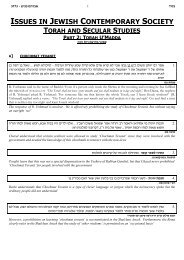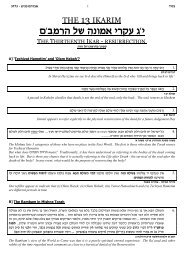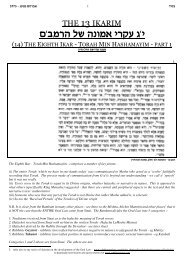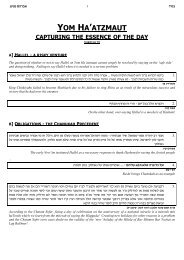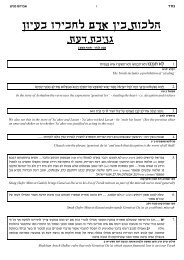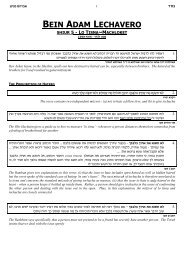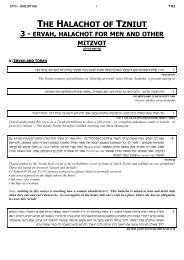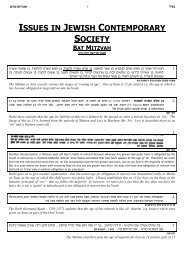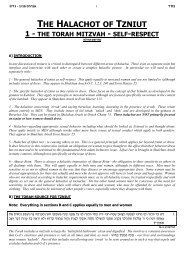Halacha in Modern Times - Class - Rabbi Anthony Manning
Halacha in Modern Times - Class - Rabbi Anthony Manning
Halacha in Modern Times - Class - Rabbi Anthony Manning
Create successful ePaper yourself
Turn your PDF publications into a flip-book with our unique Google optimized e-Paper software.
dbhbn ovrct<br />
1<br />
sxc<br />
WINDS OF CHANGE<br />
DOES HALACHA ADAPT TO MODERN TIMES<br />
SHIUR 7 - MICROHALACHA, METAHALACHA AND THE HASHKAFIC MATRIX<br />
rsbk iufn<br />
A] THE SMALL PICTURE - MICROHALACHA<br />
Halachic analysis (psak as def<strong>in</strong>ed by Rav Aharon Lichtenste<strong>in</strong> <strong>in</strong> Shiur 6) is made up of millions of t<strong>in</strong>y details. Of these<br />
these details produce op<strong>in</strong>ions which are not ‘ma<strong>in</strong>stream’. When is it legitimate to br<strong>in</strong>g out these op<strong>in</strong>ions to permit<br />
new <strong>in</strong>novations.<br />
1. It is this concept which undergirds the legitimacy of recourse to m<strong>in</strong>ority op<strong>in</strong>ions bi-sha’at ha-dehak. Inasmuch as these<br />
op<strong>in</strong>ions are not simply dismissed as erroneous but procedurally rejected ... they are very much alive, held <strong>in</strong> reserve where<br />
they can be culled from the shelf <strong>in</strong> a crisis. In effect, the pr<strong>in</strong>ciple of "<strong>Rabbi</strong> So-and-so is worthy of be<strong>in</strong>g relied on <strong>in</strong> exigent<br />
circumstances," states, that while a given view has been accepted le-halakha, as part of our third tier, <strong>in</strong> an emergency we<br />
envision ourselves back at our middle tier, sans decisive resolution, and hence as authorized to heed another view. Moreover -<br />
and this is no less remarkable - under the pressure of circumstance, we are not bound by the general directive of sfeka<br />
de-oraita le-humra, but are entitled to follow a lenient m<strong>in</strong>ority. 1<br />
This license raises obvious questions. How liberally and by whom can it be exercised From how far back can discarded shitot<br />
be extracted - from the mishna, the gemara, rishonim, early aharonim Which views, if any, might <strong>in</strong>deed be treated as error,<br />
and on what basis At the practical plane, these issues need to be clarified, but that task lies beyond my present scope. Here,<br />
I content myself with an account of the pr<strong>in</strong>ciple and its rationale, as a manifestation of concern for the human and social<br />
element with<strong>in</strong> pesika.<br />
The Human and Social Factor <strong>in</strong> <strong>Halacha</strong>- Tradition Magaz<strong>in</strong>e 36:1 p 11<br />
Important Micro-factors <strong>in</strong> Legimis<strong>in</strong>g the Use of M<strong>in</strong>ority Op<strong>in</strong>ions<br />
• Honesty - accurate and contextual quot<strong>in</strong>g eg legitimate use of a hava am<strong>in</strong>a<br />
• Consistency - with other areas of psak<br />
• Weight<strong>in</strong>g - how to weigh different halachic (and haskafic) precedents aga<strong>in</strong>st others; rishonim vs acharonim;<br />
‘big-names’ vs smaller<br />
B] THE BIG PICTURE - METAHALACHA<br />
2 The discussion regard<strong>in</strong>g women’s tefilla groups has regrettably focused excessively on technical issues<br />
and legalities. It has been framed by limited halakhic queries such as: may the participants forgo tefilla<br />
be-tsibbur to attend these groups May menstruant women touch sifrei Torah Undoubtedly such<br />
technical perspectives and narrow questions are necessary to ensure our compliance with all m<strong>in</strong>utiae of<br />
halakha. Torah, however, consists not only of halakhic details, but also of halakhic values.<br />
Unfortunately the latter have been neglected <strong>in</strong> the discussion concern<strong>in</strong>g women’s tefilla groups. When<br />
halakha is fragmented and truncated <strong>in</strong> such a fashion, it can be neither <strong>in</strong>terpreted nor implemented<br />
correctly. The approach of Rav Soloveitchik zt”l differed. The Rav’s consistent opposition to women’s<br />
tefilla groups was dictated by halakhic values, not halakhic details.<br />
"Halakhic Values and Halakhic Decisions: Rav Soloveitchik's Pesak Regard<strong>in</strong>g Women's Prayer Groups" Rav Meyer<br />
Twersky Tradition, 32:3 Spr<strong>in</strong>g 1998 - see http://www.torahweb.org/torah/special/2003/rtwe_wtg.html#fn10<br />
1. This position is subject to halachic debate and not universally agreed upon
dbhbn ovrct<br />
2<br />
sxc<br />
3. In sum, halakha is a two-tiered system consist<strong>in</strong>g of concrete, particularized commandments govern<strong>in</strong>g<br />
our actions as well as abstract, general imperatives govern<strong>in</strong>g the matrix of our actions. Some abstract<br />
imperatives focus exclusively on the elan of a specific mitsva; e.g., the commandment Shabbaton<br />
ensures the spiritual character of Shabbat. Others are all-encompass<strong>in</strong>g, establish<strong>in</strong>g universal values<br />
and standards of conduct; e.g. kedoshim te-hiyu. The Torah legislates not only actions, but also de’ot<br />
(ethical-moral-religious-<strong>in</strong>tellectual dispositions). It prescribes ritual but also establishes boundaries for<br />
the concomitant religious experience.<br />
ibid<br />
:Wh¤,«c£tk v gC§J°b r¤J£t vc«Y©v .¤rẗ¨v ,¤t ¨T§J©r²h±u ¨,tcU Qk c©yh°h ig©nk v h‾bhgC cIY©v±u r¨J²H©v ¨,h¦Gg±u 4.<br />
jh:u ohrcs<br />
One of the mitzvot is to do what is ‘upright and good’. Why is this a separate mitzva - aren’t all of the mitzvot meant to<br />
be yashar and tov How are we to judge whether our idea of what is straight and good is <strong>in</strong> accordance with Hashem’s<br />
rat uh,usgu uh,uej runa,a rnt vkj,n hf 'vzc vbuufvu /ihsv ,ruan ohbpku vrap uz urnt 'vph arsn vzc ubh,ucrku 5.<br />
hta hpk 'kusd ihbg vzu :rahvu cuyv cvut tuv hf 'uhbhgc rahvu cuyv ,uagk l,gs i, lum tk ratc od rnth v,gu 'lum<br />
rhfzva hrjt kct 'okf ,ubhsnvu cuahv hbue,u ub,nu utan kfu uhgru uhbfa og ostv ,udvbv kf vru,c rhfzvk rapt<br />
tmuhfu ' oue, vcha hbpn 'arj kke, tk 'lgr os kg sung, tku 'ruy, tku oue, tk 'khfr lk, tk iudf 'vcrv ovn<br />
ihsv ,ruan ohbpku vrapv vzc xbfha sg 'rcs kfc rahvu cuyv vagha kkf lrsc rnuk rzj 'ivc<br />
oa i"cnr<br />
The Ramban expla<strong>in</strong>s that, although the Torah <strong>in</strong>cludes hundreds of mitzvot and thousands of details, it could not<br />
possibly legislate specifically for every case <strong>in</strong> every time and place. It therefore <strong>in</strong>cludes this general mitzvah be<strong>in</strong><br />
adam lechavero which requires us to be fair and honest and use our moral and ethical judgement <strong>in</strong> all circumstances<br />
This is a parallel to the mitzvah of ‘kedoshim tihiyu’ (see Vayikra 19:2) <strong>in</strong> mitzvot be<strong>in</strong> adam lemakom. A person might<br />
be a gross glutton and get drunk all day eat<strong>in</strong>g kosher meat and dr<strong>in</strong>k<strong>in</strong>g kosher w<strong>in</strong>e and never technically break any<br />
mitzvah. Kedoshim tihiyu comes to tell us that we have an overrid<strong>in</strong>g obligations to be ‘holy’ - i.e. to follow the spirit of<br />
the law and be bigger people. So too <strong>in</strong> <strong>in</strong>terpersonal relations, we must not allow the letter of the law to deflect us from<br />
the spirit of the law<br />
:ofh¥vO¡t v h°b£t JIsë hF Uh§v¦T oh¦J«s§e o¤vk£t ¨T§r©nẗ±u k¥t¨r§G°h h‾bC ,©sg kF k¤t rC©S<br />
6.<br />
c:yh trehu<br />
kgc tmnh f"t 'ihhvu racv ,khftu u,atc aht vthcv vrh,vu ohruxtv ohkftncu ,uhrgc vrhvzv vru,v hf ihbgvu 7.<br />
',ukcbv kfc ubumrf rcshu 'unk rac hkkuzc ihh htcuxc ,uhvku ',ucrv uhab ut u,at ,nzc ;uya ,uhvk ouen vut,v<br />
o,ut rxta ohruxhtv yrpa hrjt 'cu,fv tc lfhpk :vru,v ,uarc kcb vhvh vbvu 'vru,c vz ruxht rfzuv tka<br />
hyrp ,rvzt hrjt hf 'vzc tmuhfc kukfku yurpk vru,v lrs vzu ////// ,ur,unv <strong>in</strong> ohaurp vhvba hkkf rcsc vumu 'hrndk<br />
,uca, rntba hkkf vagc ohjryvu utkc ,uftknv rxt ',cav ihbgc ifu //// cuyvu rahv ,hagu kkfc rnt ////ihbhsv<br />
c:yh trehu i"cnr<br />
The methodology of the Torah is to supplement the details of mitzvah with Torah ‘meta-pr<strong>in</strong>ciples’ which provide the<br />
context and backdrop to our practice of the mitzvot generally and sets the ‘spirit’ of the law<br />
8. …while, of course, for the committed Jew, halakha, as a normative order, can never be superseded by external pressures, a<br />
specific halakha may be flexibly applied and, <strong>in</strong> a sense, superseded by the <strong>in</strong>ternal dynamics of the halakhic system proper.<br />
And this, <strong>in</strong> two dist<strong>in</strong>ct, albeit related, ways. The first entails recourse to a phalanx of factors, of human and social import,<br />
which affect decision as acknowledged halakhic elements. At the apex stands, of course, pikuah nefesh, but other factors,<br />
local or general, of lesser gravity, also abound. These <strong>in</strong>clude physical and psychological pa<strong>in</strong>, f<strong>in</strong>ancial hardship, social<br />
harmony, and human dignity, sensitivity to any or all of which can affect pesak measurably.<br />
The Human and Social Factor <strong>in</strong> <strong>Halacha</strong> Tradition Magaz<strong>in</strong>e 36:1 p 10
dbhbn ovrct<br />
3<br />
sxc<br />
C] YIRAT SHAMAYIM<br />
• Commitment to the assumptions of the ‘halachic process’ - the Chatimat HaShas, Torah M<strong>in</strong> Hashamayim<br />
• Avoidence of ‘foreign’ agendas - egalitarianism; political correctness; n.b.hashkafic difficulty of identify<strong>in</strong>g what is<br />
‘foreign’<br />
D] DERACHEHA DARCHEI NOAM<br />
ouka vh,uch,b kfu ogub hfrs vhfrs (wd hkan) :k", !ohhjf oh,n vagb tka ihs ubht 9.<br />
:zp ,unch<br />
The Gemara tries to prove technically that a woman who was exempted from Yibum through hav<strong>in</strong>g a child and then<br />
subsequently remarries should be re-subjected to chalitza if that child dies. This is rejected on the grounds of<br />
“Deracheha Darche Noam”<br />
vkgc kg vbd,n thv hrv .ukj, rnt, ot vbc ,nu euak ,xhbu ochk veezb tku ic vk vhva uzu - ogub hfrs vhfrs 10.<br />
oa h"ar<br />
Rashi expla<strong>in</strong>s that this suggestion would be offensive to her relationship with her new husband and is thus disqualified<br />
E] DARCHEI SHALOM<br />
'iah ,hcc ihcrgn `ouka hfrs hbpn 'ktrah uhrjtu huk uhrjtu iuatr true ivf :ouka hfrs hbpn urnt ohrcs ukt /whb,n<br />
'kzd ouan ivc ah ohdsu ,upugu vhj ,usumn `ouka hfrs hbpn 'iuatr tkn,n vntk cure tuva ruc `ouka hfrs hbpn<br />
/ouka hfrs hbpn 'vtpu vjfa yekc ohcfuf hscug hhbg shc ihjnn iht ////// ouka hfrs hbpn<br />
11.<br />
/yb ihyhd<br />
hbpn 'ktrah h,n og ohrfb h,n ihrcueu 'ktrah hkuj og ohrfb hkuj ihrecnu 'ktrah hhbg og ohrfb hhbg ohxbrpn :r", 12.<br />
ouka hfrs<br />
/tx ihyhd<br />
Chazal <strong>in</strong>sisted on certa<strong>in</strong> changed to the default halachic position <strong>in</strong> order to achieve Shalom - between Jews and<br />
between Jews and non-Jews<br />
F] EIT LA’ASOT LASHEM<br />
urnthu 'ofng wv :ohrmuek rnthu ojk ,hcn tc zgc vbvu (wc ,ur) :rntba 'oac urcj ouka ,t ktua ost tvha ubhe,vu 13.<br />
/wvk ,uagk ,g ouan l,ru, urpv :rnut i,b hcr /l,ru, urpv wvk ,uagk ,g (y"he ohkv,) :rnutu /////`wv lfrch :uk<br />
/sb ,ufrc<br />
Boaz <strong>in</strong>stituted the common usage of G-d’s name <strong>in</strong> socail greet<strong>in</strong>gs <strong>in</strong> order to promote Shalom. The Gemara justifies<br />
this on the grounds of ‘Et La’asot Lashem’<br />
ubumr vz urcj oukak kutak ihuf,nv 'vz ;t 'wvk ,uagk hsf vru, hrcs ohkycna ohngp - l,ru, urpv wvk ,uagk ,g rnutu 14.<br />
ruxt vtrbv rcs ,uagku vru, rpvk r,un 'uvpsru ouka aec rntba 'ouen ka<br />
oa h"ar<br />
Rashi expla<strong>in</strong>s that the halacha conta<strong>in</strong>s the ability to reverse even apparent Torah positions <strong>in</strong> order to achieve the<br />
ultimate will of Hashem. Who excercises this power and under what circumstances<br />
;uxc !ihrbhsc vhvha sg vkhkv ihkt tk 'vzv iugnv :kthknd ic iugna icr rnt 'cvz rbhsc ohkaurhc ihbhe usnga vagn 15.<br />
vhkg rtav ihtu ohjczc ,kfutu sjt icre vthcn - ,utsu ,uchz wv ',utsu ,ushk wv vhkg aha vatv :snku s"ck xbfb<br />
oh,gcrc tuvv ouhc ihbhe usngu 'vcuj<br />
/j ,u,hrf<br />
Another example - R. Shimon ben Gamliel reversed a halacha that women needed to br<strong>in</strong>g a korban for each birth, <strong>in</strong>
dbhbn ovrct<br />
order to br<strong>in</strong>g down the exhorbatant price of birds!<br />
4<br />
sxc<br />
;udv ,tnuyc ohasec ukfthu sjt ukhpt thcvkn uksjh utmnh tk hknkta tuv wvk ,uagk ,g vru, hrcs kg kehva p"gt 16.<br />
oa h"ar<br />
Rashi expla<strong>in</strong>s that the damage to Torah by NOT chang<strong>in</strong>g the halacha outweighed the problem of the change itself<br />
ihc lrsc tuv ot n"nu /ktrah ihcu ivf ihc gunak ruxtu vurg kkfc f"d thv ,hrfb vhubp rnz kueu ///// - vat rnz 17.<br />
ubta iuhf f"kts lrcku ,urek r,un w,hhrutsn vurg hrens ubhmn tks iuhf ,ujnk uk t"ta xubt tuvu rhgc ut o"ufgv<br />
tuva vausevk ihufk uck .nt,h lt l,ru, urpv wsk ,uagk ,g rntb z"gu vkp,u vru,n kyc,b o"ufgv ihc ihhura<br />
rnzv kuek uck i,h tku exug<br />
vg <strong>in</strong>hx vrurc vban<br />
The Mishna Berura applies this to permitt<strong>in</strong>g learn<strong>in</strong>g and daven<strong>in</strong>g whilst listen<strong>in</strong>g to non-Jewish women s<strong>in</strong>g<strong>in</strong>g.<br />
There is no alternative and a person cannot live without Torah and Tefilla!<br />
Cirtcumstances <strong>in</strong> which Et La’asot has been <strong>in</strong>voked<br />
• Writ<strong>in</strong>g of the Oral Law<br />
• Us<strong>in</strong>g a Book of Haftorot <strong>in</strong> shul<br />
• Us<strong>in</strong>g Hashem’s name <strong>in</strong> social greet<strong>in</strong>g<br />
• <strong>Modern</strong> <strong>in</strong>troduction of changes <strong>in</strong> women’s learn<strong>in</strong>g<br />
• Shimon Hatzadik go<strong>in</strong>g out to greet Alexander <strong>in</strong> the Bigdei Kehuna<br />
oak u,buuf er vchj lrs vaug ubhta kfa 't"f whx z"gvctc t"nrv c,fa vn h"pg asue ,urhnz rh,vk ;hbx sug ahu 18.<br />
;tu 'ohabc ohan,an ubta t,av ohfnux ubt z"ga 'a"ak kfv v"s t 'c"p ihaushe wxu,c uhrcs ruenu /r,un 'ohna<br />
hsf 'a"ak ohbuuf,n f"d asue ,urhnz ohrnznva iuhf rnuk ah n"n 'rnz kue ,ghna ihcu ohabc aunha ihc ekjk aha<br />
hcd (/yx) tnuh wxnc whgu /ohkhenv kg lunxk ah 'ktrah hasek vchj ockc ,gyku ,ubcv kmt ohh,s ,uadr rrugk<br />
,g ouan p"gca vru, hrcs cu,fk urh,va t,ht c 's"h vrun, wxncu /oa h"arhpcu wufu wvk ,uagk ,g :ehsmv iugna<br />
usnk t (/x) ihyhd wxncu 'ktrahn vru, jf,a, tku vru,v <strong>in</strong> ,jt ,ut regh, cyun :urntu 'l,ru, urpv wvk ,uagk<br />
/l,ru, urpv ,uagk ,g rapt tks iuhf ouan t,rypt rpxc ,ureku kykyk r,una vzn<br />
jhr sung zg <strong>in</strong>hx t ekj at hshra ,"ua<br />
Recently, Rav Yechiel Yaakov We<strong>in</strong>berg <strong>in</strong> his famous teshuva on mized s<strong>in</strong>g<strong>in</strong>g for zemirot uses Et La’asot Lashem as<br />
one of the ma<strong>in</strong> justifications for his chidush. Note (here and elsewhere <strong>in</strong> the tueshuva) how he first f<strong>in</strong>ds a (weak)<br />
technical justification (snif) for the heter and then <strong>in</strong>vokes the real metahalachic pr<strong>in</strong>ciple of Et Laasot<br />
/vru, uc rpvk r,un - ouen ka unak rcs ,uagk ,g tcaf - wvk ,uagk ,g<br />
19.<br />
/yx tnuh h"ar<br />
F] KAVOD HABERIYOT<br />
aha ouen kf - wv sdbk vmg ihtu vbuc, ihtu vnfj iht - (k:tf hkan) tngy htn 'euac ukhpt iyaup usdcc ohtkf tmunv<br />
//// crk sucf ihekuj iht oav kukj<br />
/// - !wv sdbk vmg ihtu vbuc, ihtu vnfj iht :tnhk htntu /vru,ca vag, tk ,t vjusa ,uhrcv sucf kusd :gna t,<br />
/ibcr ura usucf ouanu 'rux, tks utk kg uvbhfnxt ibcrs hkhn kf //// rux, tks (th:zh ohrcs) utkc<br />
vhv ot smhf tv `ovn okg,n v,t ihta ohngpu ovn okg,n v,ta ohngp - ovn ,nkg,vu (t:cf ohrcs) :gna t,<br />
htnt /,nkg,vu :rntb lfk 'urcj kan vcurn u,ftkn v,hva ut 'usucf hpk vbhtu iez vhv ut ',urcev ,hcc thvu ivf<br />
/ibhpkh tk tbunnn truxht ///// !wv sdbk vmg ihtu vbuc, ihtu vnfj iht :tnhk<br />
20.<br />
(a)<br />
(b)<br />
(c)<br />
kufh //// ,n uk ,na gnau ubc ,t kunku ujxp ,t yujak lkuv vhva hrv rnuk sunk, vn u,jtku (z:u rcsnc) :gna t, (d)<br />
tuv tnyn kct 'tnyn ubhts tuv u,ujtk - u,ujtku :rnuk sunk, 'vumn ,nk tnyn ubht lf ovk tnyn ubhta oaf<br />
/hbta vag, ktu ca ////- /wv sdbk vmg ihtu vbuc, ihtu vnfj iht :tnhk htnt 'vumn ,nk<br />
:yh ,ufrc<br />
There are a number of situations where the halacha is sometimes overridden by the pr<strong>in</strong>ciple of kavod for other people:-<br />
(i) rabb<strong>in</strong>ic mitzvot ; (ii) monetary mitzvot; (iii) passive non-observance of positive Torah mitzvot
dbhbn ovrct<br />
5<br />
sxc<br />
n"n 'hfv k"he tks d"gtu hra vpujk vxhbfv v v"vs raptu ohbcu vat uk ihts tfhv asek ihrh,n ahu :vdv /ihasen ////iht 21.<br />
sg wu ouhc thbusbv og ,uuavk ohkufh uhv tka ohngpka ihkhdra unf `,uhrcv sucf kusd hf od 'ejsv ,gac vz kg ihfnux<br />
n"nu `zt xubfh tk ot i,jku vkfk auhc huvu ihtuabku vsugxk ubhfv rcfu khtuv ,ca khkc ihaushevu vpujv ihaugs 'vkhkv<br />
/lf hshk tch tka rvzhk ah vkj,fk<br />
s ;hgx yka <strong>in</strong>hx ohhj jrut lurg ijkua<br />
The Rema permits a chuppah on Shabbat <strong>in</strong> exceptional circumstances - here where the chatan and kallah were already<br />
under the Chuppah on Friday afternoon and an argument amongst the family caused the Chuppah to be delayed until<br />
Shabbat. Out of kavod haberiut - concern for the dignity of the bride, the Rema allows the wedd<strong>in</strong>g - this was based on<br />
an actual and very controversial case <strong>in</strong> Krakow when this happened<br />
G] AVOIDING HETERODOX PRACTICES<br />
tka ,hbg,cu spxvc ihr,unu uhkfc ack,n kusd ivf ihtu ,cav rjt jucy ouha ,cac ,uhvk kj ota ohsunu ///// 22.<br />
,cav rjt ,rmg ihrnutv hrcs ohhek<br />
s vban c erp vdhdj ,fxn vban<br />
The Mishna rules that when Shavuot fell on Shabbat and many of the korbanot had to be brought the follow<strong>in</strong>g day on<br />
Sunday, the Yom Tov element of the Sunday was deliberately down-played to avoided strngthen<strong>in</strong>g the sectarian<br />
practices of the Sadduces who held that Shavuot MUST fall on a Sunday<br />
,t vejh tka 'if vagh tk euacu `vfu,k osv xbfha khcac u,hc lu,c tnud vaug kct 'rehg kf tnudk ihyjua iht 23.<br />
(euj iuak vejh 'ovh,ueujc ovhsh ehzjh - h"ar) :[ohbhnv] oheusmv<br />
/tn ihkuj<br />
The Mishna prohibits shechita <strong>in</strong> a way which would give support to sectarian practices of ‘non-orthodox’ groups, even<br />
though the <strong>in</strong>novation is itself halachically permissible. There have always been such group - Samaritans, Sadduces,<br />
Early Christians. Today, this would apply to adopt<strong>in</strong>g practices which would strengthen the position of non-orthodox<br />
groups - Conservative, Reform<br />
tuv ruxt ohxruehptv ka huehj kfu 'vnruphrv ,t ,ezjn vru,v ,threc vuuknu ,hkyc ,upuyg ivaf ohabv ,khp, 24.<br />
vaug v,hv 'vc vuumn thv ihta vumn ouhec ,eauj vat v,hv ,ntc ukht ift /(yne whx n"uj rzb-hbct whg) vru,vn<br />
iumrn gcub rcsva rurc 'ohcrcu vhxvrpc ,uauga kf kct /ohxruehptv ka ohhuehj ouan rcsc iht ztu 'vrsjc ,tz<br />
/ruxt tuv if kgu 'huehjv<br />
vhxvrpc ohab ,khp, q drcskud vhnjb <strong>in</strong>kz crv q jh lrf q ihnuj,<br />
Here, Rav Zalman Nechemia Goldberg rules that publc women’s prayer services with tallitot and kriyat haTorah as an<br />
issur Torah based on this prohibition.<br />
This has been applied over the last 200 years <strong>in</strong> various questions:-<br />
- prohibit<strong>in</strong>g organs <strong>in</strong> synagogues<br />
- prohibit<strong>in</strong>g flowers at funerals<br />
- prohibit<strong>in</strong>g changes to synagogue design<br />
- prohibit<strong>in</strong>g change <strong>in</strong> pronunciation for an Ashkenazi to 'modern’ pronunciation<br />
But consider ‘heterodox’ practices that were accepted (at least to some degree) by Orthodox poskim and communities:-<br />
• sermons <strong>in</strong> the venacular<br />
• Bat mitzva/ Bat Chayil
dbhbn ovrct<br />
6<br />
sxc<br />
ehzjh h"arhpu ohbhnv ,t vejh tka if vagh tk euacu wufu u,hc lu,c tnud vaug kct t"g t"n ihkuj whb,nc ubhba 25.<br />
vag otu ufk, tk ovh,ueujcu rntba ouan if vagh tk euacu t,hhrcc oa t,htu /euj iuak vejh ovh,ueujc ovhsh<br />
ouan vrh,vk iht n"n z"g ,ueuj ouan kgdrtc ihta rnuk ssmb ot ;ta rnut hbt v,gnu /uhrjt vehsc lhrm if<br />
'ws ,sc ,umrp .urpk ohxrvnv vzc ukhj,va gush hrva '(ovh,ueujc ovhsh ehzjna rnukf) ohxruehptv vzc vejna<br />
ohbcrv hbhg ,urnk kgdrtv og urcj ,urjt ,ucgu, sugu jhanv ,thcc urpfu ,ukp,v uba thxvrpc ,ca ukkj<br />
/ubhrjt <strong>in</strong>t ohbug ohbcrvu ohbre ubk ubjek ubezjc tkv ohxrvnv urnth tkv kgdrtv rh,b ot v,gu /ws rcsk ohsrjv<br />
r,hvc uehpxh tk ogva shgn iuhxbv ,ntcu /o,kcux ,gv jur iht )o,gs hpf( rat ohruxht rta od urh,hu ygn sugu<br />
vbgku aur vrup aruak vhvb :kgdrtv rat ubka vbntb vgsuvc ubc,f esmcu tuav hkcjc iugv ohfaun ot hf ygn<br />
kfhvc gnab ,ura ohab ,ukven kue kgdrtv kdrku ohnhv ufrth tk hf ',ukusd ,ucgu,u ,urjt ,urhcg ,rrud vrhcgk<br />
h"g 'iugrdu vpxuv hsh kg ckca vsucgv ,u,a uxrvbu 'vmrp rjt vmrp vmrpb ubh,uctn ubkce rat vkp,v rsxcu /ws<br />
vsucgv rsxu iuhmk u,bhfa chavk 'uhthcb h"g wv ,ujycvc uygcu ohxrvnv urpf hf 'ushghu ubgh rat ohpukju ohhuba<br />
,t ohehzjnu ohxruehptvu ohbhnv vzc ohejna hbpn kgdrtc r,uh ruxht ah ubbnzc f"tu /ohnhv ,hrjtc ohkaurhk<br />
/,svu vbuntv ,uxhrvc ovhsh<br />
zy <strong>in</strong>hx (ohhj jrut) t ekj khguvk snkn ,"ua<br />
Here Rav David Tzvi Hoffman totally prohibits hav<strong>in</strong>g an organ <strong>in</strong> a synagogue, even on a weekday for this reason<br />
26. Mesora encompasses not only analytic novella, abstract theories, halakhic formulae and logical<br />
concepts . . . but also ontological patterns, emotions and reactions, a certa<strong>in</strong> existential rhythm and<br />
experiential cont<strong>in</strong>uity. Complete transmission of the mesora is only possible by means of <strong>in</strong>timate<br />
connection with the previous generation.<br />
Rav Soloveitchik, BeSod haYahid ve-haYahad, p. 270.<br />
/<br />
27. There are two covenants: the first which God concluded with the patriarchs, and the second which God<br />
concluded with Moses on Mt. S<strong>in</strong>ai. The nature of the S<strong>in</strong>aitic covenant was a commitment to the<br />
fulfillment of commandments. It is a bond of obligation. The patriarchal covenant on the other hand, has<br />
no commandments <strong>in</strong>cluded <strong>in</strong> it with the exception of circumcision. Yet the two are connected . . . The<br />
S<strong>in</strong>aitic covenant relates to the human deed. The patriarchal covenant relates to the fundamental essence<br />
of a person. It teaches man how to feel or to experience as a human be<strong>in</strong>g.<br />
Rav Soloveitchik, Shiurei haRav, p. 51.



